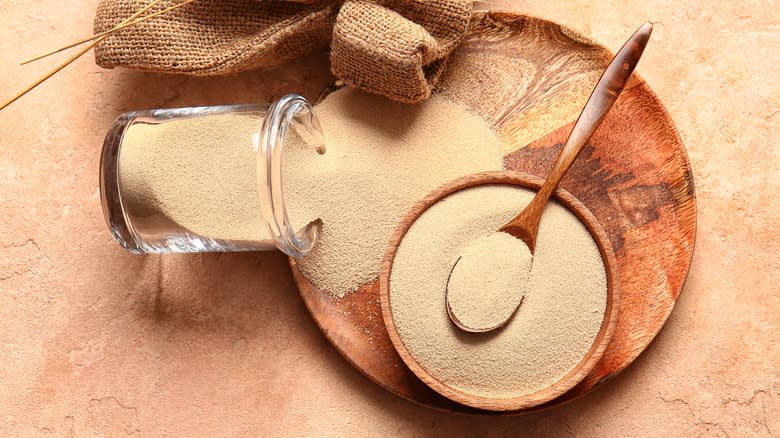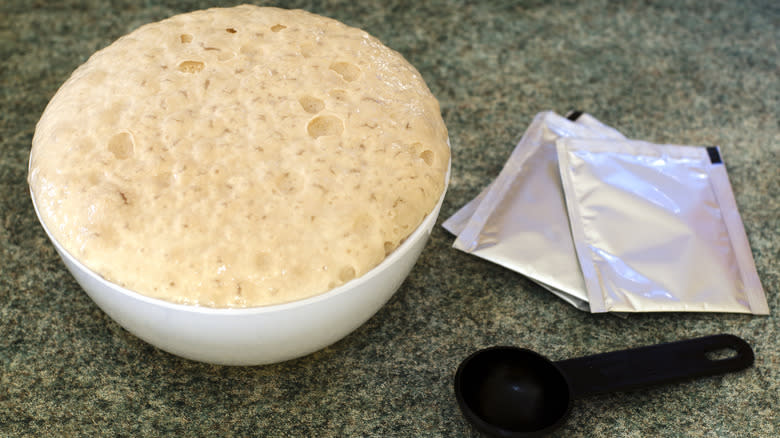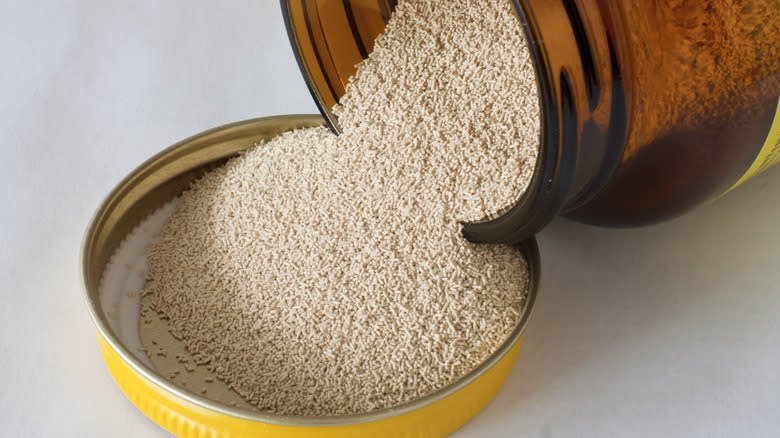Here's How To Test Yeast To Make Sure It's Still Active

We may receive a commission on purchases made from links.
Given its place amongst the rest of your baking supplies and pantry staples, it can be easy to think of yeast as an infinitely shelf-stable powder that can be stockpiled and brought out for use whenever it's needed. The unfortunate reality is that, much like how baking soda loses freshness over time, yeast has a set expiration date after which it loses most, if not all, of its essential properties. While yeast can last up to two years if unopened, its lifespan is much more variable after opening, depending on how you store it and where. If you're not sure whether your yeast is still viable or not, the quickest way to check is to place it in some sugar and water and see if it activates.
This process is called proofing the yeast and is essentially "feeding" the yeast to wake it up. Despite seeming like a dry powder like any other powdered baking supply in your pantry, yeast is actually a collection of living microorganisms — the single-celled Saccharomyces cerevisiae — that serve as the biological catalyst for the rising and fermentation of bread. If the yeast is dead, it can't metabolize sugars and produce carbon dioxide and ethanol, meaning that your dough won't rise or take on that distinctive fresh bread aroma — which is why you should always check the viability of questionably stored or old yeast before use.
Read more: The Best Way To Clean That Nasty Grease Off Of Your Kitchen Cabinets
How To Proof The Yeast

The process for checking yeast activity is pretty much the same for any kind of yeast, including instant yeast, active dry yeast, and fresh yeast. First, you'll want to prepare a bowl of warm water at around 110 degrees Fahrenheit. Check with a thermometer to ensure that it doesn't go above 120 degrees Fahrenheit, as that risks damaging or killing off the yeast from the heat alone.
Once you've checked that the water is at a safe and effective temperature, mix in a teaspoon of sugar and stir until it dissolves. Then, sprinkle about 2 teaspoons of yeast over the water-sugar mixture. Alternatively, take about 2 teaspoons of fresh yeast and crumble it over the water. Mix the yeast in, then let it sit undisturbed for about five to 10 minutes. During this time, the yeast should start to activate and create a frothy or foamy layer on the surface of the water. If the yeast is still active and robust, you will likely see bubbles forming immediately.
After the waiting period, visually inspect the yeast mixture. It should be frothy, and you should see bubbles on the surface. The foam indicates that the yeast is consuming the sugar and producing carbon dioxide, which is a sign of its activeness. Another thing to look for is the smell: Active yeast produces a distinctly yeasty aroma. If you detect the sweet and bright smell of freshly baked bread or faint hints of beer, your yeast is active and ready to go.
What To Do With Dead Yeast

If there is minimal to no activity, and the mixture remains flat without bubbles or foam, then the yeast is likely too inactive to be of any use in baking. Unfortunately, you can't revive dead yeast — while you may or may not be able to wring some amounts of activity from partially-expired yeast, dead is dead, and it's better to just get a fresh batch of live leavener for your kitchen. Thankfully, yeast is compostable, so you can discard it through your local compost system or at home in your garden.
As with many other things in life, the best way to deal with dead yeast is prevention before it happens. Make sure to seal your yeast in airtight containers, store them away from heat and sunlight, and keep track of their best-before dates to make the most of your yeast before it expires.
Read the original article on Daily Meal.

